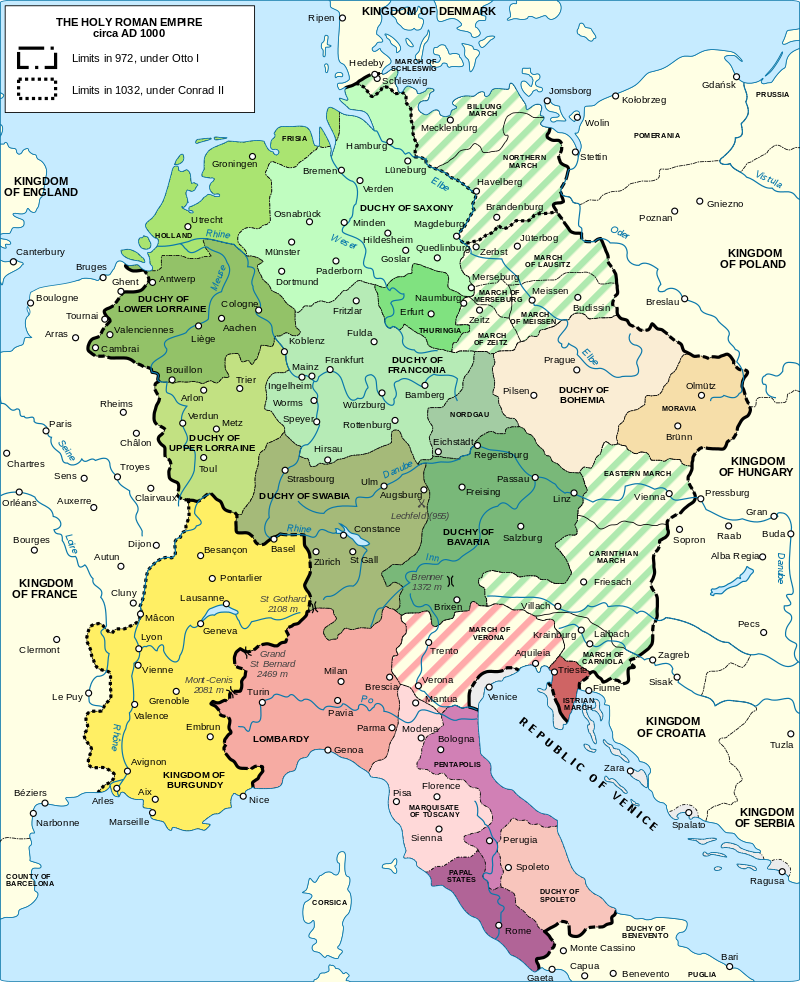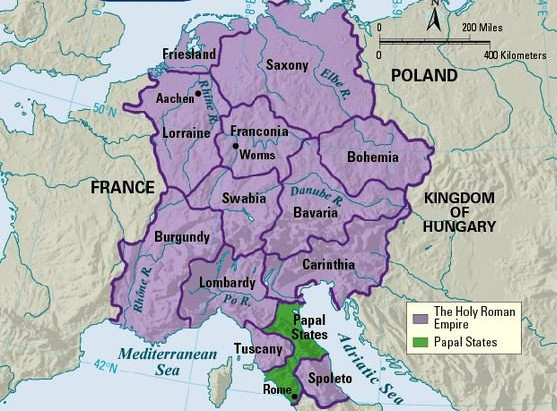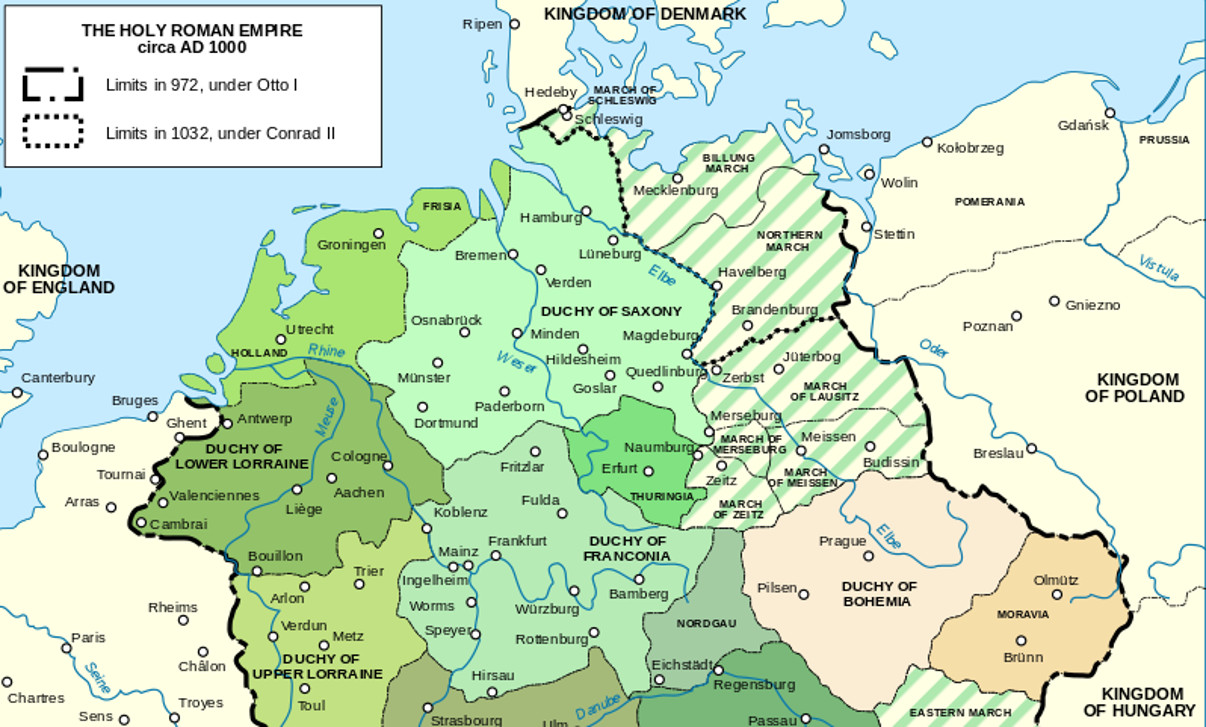The Holy Roman Empire during the High Middle Ages
Introduction
The Holy Roman Empire (Latin: Sacrum Imperium Romanum, German: Heiliges Römisches Reich) was a multi-ethnic complex of territories in central Europe that developed during the Early Middle Ages and continued until its dissolution in 1806. The largest territory of the empire after 962 was the Kingdom of Germany, though it also came to include the Kingdom of Bohemia, the Kingdom of Burgundy, the Kingdom of Italy, and numerous other territories.
On 25 December 800, Pope Leo III crowned the Frankish king Charlemagne as Emperor, reviving the title in Western Europe, more than three centuries after the fall of the Western Roman Empire. The title continued in the Carolingian family until 888 and from 896 to 899, after which it was contested by the rulers of Italy in a series of civil wars until the death of the last Italian claimant, Berengar, in 924. The title was revived in 962 when Otto I was crowned emperor, fashioning himself as the successor of Charlemagne and beginning a continuous existence of the empire for over eight centuries. Some historians refer to the coronation of Charlemagne as the origin of the empire, while others prefer the coronation of Otto I as its beginning. Scholars generally concur, however, in relating an evolution of the institutions and principles constituting the empire, describing a gradual assumption of the imperial title and role.
The precise term "Holy Roman Empire" was not used until the 13th century, but the concept of translatio imperii, the notion that he held supreme power inherited from the emperors of Rome, was fundamental to the prestige of the emperor. The office of Holy Roman Emperor was traditionally elective, although frequently controlled by dynasties. The German prince-electors, the highest-ranking noblemen of the empire, usually elected one of their peers as "King of the Romans," and he would later be crowned emperor by the Pope; the tradition of papal coronations was discontinued in the 16th century. The empire never achieved the extent of political unification formed in France, evolving instead into a decentralized, limited elective monarchy composed of hundreds of sub-units, principalities, duchies, counties, Free Imperial Cities, and other domains. The power of the emperor was limited, and while the various princes, lords, bishops and cities of the empire were vassals who owed the emperor their allegiance, they also possessed an extent of privileges that gave them de facto independence within their territories. Emperor Francis II dissolved the empire on 6 August 1806, after the creation of the Confederation of the Rhine by Napoleon.
What's in a Name?
In various languages the Holy Roman Empire was known as: Latin: Sacrum Imperium Romanum, German: Heiliges Römisches Reich, Italian: Sacro Romano Impero (before Otto I), Italian: Sacro Romano Impero Germanico (by Otto I), Czech: Svatá říše římská, Slovene: Sveto rimsko cesarstvo, Dutch: Heilige Roomse Rijk, French: Saint-Empire romain (before Otto I), French: Saint-Empire romain germanique (by Otto I)[20]. Before 1157, the realm was merely referred to as the Roman Empire. The term sacrum ("holy", in the sense of "consecrated") in connection with the medieval Roman Empire was used beginning in 1157, under Frederick I Barbarossa ("Holy Empire") – the term was added to reflect Frederick's ambition to dominate Italy and the Papacy; the form "Holy Roman Empire" is attested from 1254 onward.
In a decree following the 1512 Diet of Cologne, the name was changed to Holy Roman Empire of the German Nation (German: Heiliges Römisches Reich Deutscher Nation, Latin: Imperium Romanum Sacrum Nationis Germanicæ), a form first used in a document in 1474. The new title was adopted partly because the Empire had lost most of its Italian and Burgundian (Kingdom of Arles) territories by the late 15th century, but also to emphasize the new importance of the German Imperial Estates in ruling the Empire due to the Imperial Reform. By the end of the 18th century, the term 'Holy Roman Empire of the German Nation' had fallen out of official use. Contradicting the traditional view concerning that designation, Hermann Weisert has stated in a study on imperial titulature that, despite the claim of many textbooks, the name Holy Roman Empire of the German Nation never had an official status and points out that documents were thirty times as likely to omit the national suffix as include it.
In a famous assessment of the name, the French Enlightenment writer Voltaire remarked sardonically: "This agglomeration which was called and which still calls itself the Holy Roman Empire was in no way holy, nor Roman, nor an empire."
History of the Empire
Early Middle Ages
Before the Dark Ages
As Roman power in Gaul declined during the 5th century, local Germanic tribes assumed control. In the late 5th and early 6th centuries, the Merovingians, under Clovis I and his successors, consolidated Frankish tribes and extended hegemony over others to gain control of northern Gaul and the middle Rhine river valley region. By the middle of the 8th century, however, the Merovingians had been reduced to figureheads, and the Carolingians, led by Charles Martel, had become the de facto rulers. In 751, Martel’s son Pepin became King of the Franks, and later gained the sanction of the Pope. The Carolingians would maintain a close alliance with the Papacy.
In 768 Pepin’s son Charlemagne became King of the Franks and began an extensive expansion of the realm. He eventually incorporated the territories of present-day France, Germany, northern Italy, and beyond, linking the Frankish kingdom with Papal lands. On Christmas Day of 800, Pope Leo III crowned Charlemagne emperor, restoring the title in the west for the first time in over three centuries.
After Charlemagne died in 814, the imperial crown was disputed among the Carolingian rulers of Western Francia and Eastern Francia, with first the western king (Charles the Bald) and then the eastern (Charles the Fat) attaining the prize. After the death of Charles the Fat in 888, however, the Carolingian Empire broke apart, and was never restored. According to Regino of Prüm, the parts of the realm "spewed forth kinglets", and each part elected a kinglet "from its own bowels". After the death of Charles the Fat, those crowned emperor by the pope controlled only territories in Italy. The last such emperor was Berengar I of Italy, who died in 924.
Formation of the Empire
Around 900, autonomous stem duchies (Franconia, Bavaria, Swabia, Saxony and Lotharingia) reemerged in East Francia. After the Carolingian king Louis the Child died without issue in 911, East Francia did not turn to the Carolingian ruler of West Francia to take over the realm but instead elected one of the dukes, Conrad of Franconia, as Rex Francorum Orientalium. On his deathbed, Conrad yielded the crown to his main rival, Henry the Fowler of Saxony (r. 919–36), who was elected king at the Diet of Fritzlar in 919. Henry reached a truce with the raiding Magyars, and in 933 he won a first victory against them in the Battle of Riade.
Henry died in 936, but his descendants, the Liudolfing (or Ottonian) dynasty, would continue to rule the Eastern kingdom for roughly a century. Upon Henry the Fowler's death, Otto, his son and designated successor, was elected King in Aachen in 936. He overcame a series of revolts from an elder brother and from several dukes. After that, the king managed to control the appointment of dukes and often also employed bishops in administrative affairs.
In 951, Otto came to the aid of Adelaide, the widowed queen of Italy, defeating her enemies, marrying her, and taking control over Italy. In 955, Otto won a decisive victory over the Magyars in the Battle of Lechfeld. In 962, Otto was crowned Emperor by Pope John XII, thus intertwining the affairs of the German kingdom with those of Italy and the Papacy. Otto's coronation as Emperor marked the German kings as successors to the Empire of Charlemagne, which through the concept of translatio imperii, also made them consider themselves as successors to Ancient Rome.
The kingdom had no permanent capital city. Kings traveled between residences (called Kaiserpfalz) to discharge affairs. However, each king preferred certain places; in Otto's case, this was the city of Magdeburg. Kingship continued to be transferred by election, but Kings often ensured their own sons were elected during their lifetimes, enabling them to keep the crown for their families. This only changed after the end of the Salian dynasty in the 12th century.
In 963, Otto deposed the current pope John XII and chose Pope Leo VIII as the new pope (although John XII and Leo VIII both claimed the papacy until 964, when John XII died). This also renewed the conflict with the Eastern Emperor in Constantinople, especially after Otto's son Otto II (r. 967–83) adopted the designation imperator Romanorum. Still, Otto formed marital ties with the east when he married the Byzantine princess Theophanu. Their son, Otto III, came to the throne only three years old, and was subjected to a power struggle and series of regencies until his age of majority in 994. Up to that time, he had remained in Germany, while a deposed Duke, Crescentius II, ruled over Rome and part of Italy, ostensibly in his stead.
In 996 Otto III appointed his cousin Gregory V, the first German Pope. A foreign pope and foreign papal officers were seen with suspicion by Roman nobles, who were led by Crescentius II to revolt. Otto III's former mentor Antipope John XVI briefly held Rome, until the Holy Roman Emperor seized the city.
Otto died young in 1002, and was succeeded by his cousin Henry II, who focused on Germany.
Henry II died in 1024, and Conrad II, first of the Salian Dynasty, was elected king only after some debate among dukes and nobles. This group eventually developed into the college of Electors.
Kingdoms within the Holy Roman Empire
The Holy Roman Empire became eventually composed of four kingdoms and numerous other territories. The kingdoms were:
- -- Kingdom of Germany (part of the empire since 962)
- -- Kingdom of Italy (since 962)
- -- Kingdom of Bohemia (since 1002 as the Duchy of Bohemia and raised to a kingdom in 1198)
- -- Kingdom of Burgundy (since 1032)
High Middle Ages
The Investiture Controversy
Kings often employed bishops in administrative affairs and often determined who would be appointed to ecclesiastical offices. In the wake of the Cluniac Reforms, this involvement was increasingly seen as inappropriate by the Papacy. The reform-minded Pope Gregory VII was determined to oppose such practices, which led to the Investiture Controversy with King Henry IV (r. 1056–1106). Henry repudiated the Pope's interference and persuaded his bishops to excommunicate the Pope, whom he famously addressed by his born name "Hildebrand", rather than his regnal name "Pope Gregory VII". The Pope, in turn, excommunicated the king, declared him deposed, and dissolved the oaths of loyalty made to Henry. The king found himself with almost no political support and was forced to make the famous Walk to Canossa in 1077, by which he achieved a lifting of the excommunication at the price of humiliation. Meanwhile, the German princes had elected another king, Rudolf of Swabia. Henry managed to defeat him but was subsequently confronted with more uprisings, renewed excommunication, and even the rebellion of his sons. After his death, his second son, Henry V, reached an agreement with the Pope and the bishops in the 1122 Concordat of Worms. The political power of the Empire was maintained, but the conflict had demonstrated the limits of the ruler's power, especially in regard to the Church, and it robbed the king of the sacral status he had previously enjoyed. The Pope and the German princes had surfaced as major players in the political system of the empire.
Medieval Geography of the Holy Roman Empire

A stem duchy (German: Stammesherzogtum, from Stamm, meaning "tribe", in reference to the Germanic tribes of the Franks, Saxons, Bavarians and Swabians) was a constituent duchy of the kingdom of Germany at the time of the extinction of the Carolingian dynasty (the death of Louis the Child in 911) and the transitional period leading to the formation of the Holy Roman Empire later in the 10th century. The Carolingians had dissolved the original tribal duchies of the Frankish Empire in the 8th century. As the Carolingian Empire declined in the late 9th century, the old tribal areas assumed new identities as the subdivisions of the realm. These are the five stem duchies (sometimes also called "younger stem duchies" in reference to the pre-Carolingian tribal duchies): Bavaria, Franconia, Lotharingia, Saxony and Swabia (Alemannia). The stem duchies were retained as the major divisions of Germany under the Salian dynasty, but they became increasingly obsolete during the early high medieval period under the Hohenstaufen, and they were finally abolished in 1180 by Frederick Barbarossa in favor of more numerous territorial duchies.
The term Stammesherzogtum as used in German historiography dates to the mid-19th century, and from the beginning was closely related to the question of national unification. The term's applicability, and the nature of the stem duchies in medieval Germany consequently have a long history of controversy. The overly literal or etymologizing English translation "stem duchy" was coined in the early 20th century. While later authors tend to clarify the term by using the alternative translation "tribal", use of the term "stem duchies" has become conventional.
Duchy of Friesland
Duchy of Saxony
- Bremen
- Drežďany -- A Slavic settlement along the River Elbe.
- Hamburg -- City of Ten Gates
- Honovereburg -- A village of ferrymen and fishermen along the Leine river.
- Magdeburg
- Munster
- Paderborn
- Wifilisburg -- A Curious Little Village
Duchy of Lower Lorraine
Duchy of Upper Lorraine
Duchy of Franconia
Duchy of Bohemia
Duchy of Swabia
Duchy of Bavaria
- Nürnberg -- City of Crossroads
- Augsburg - medieval
- Regensburg
- Vienna -- medieval
Duchy of Burgundy
Duchy of Lombardy
Duchy of Carinthia

